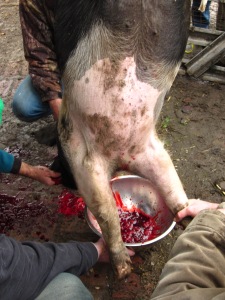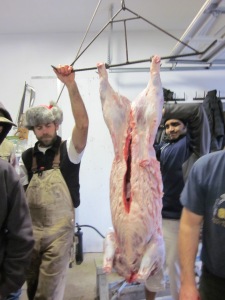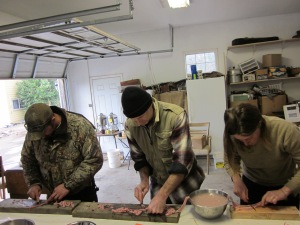Vegetarians and vegans beware! This is a very graphic post, complete with pictures, about pig slaughter and butchery.
Like many of us, I’ve spent most of my life as a conflicted omnivore. I ate meat because I thought it was nourishing and delicious, but felt uncomfortable with the suffering inflicted on farmed animals. I tried to eat mainly free-range, non-factory-farmed meat, but always wondered whether watching an animal get slaughtered might cause me to give up meat altogether.
So I hopped on the Know-Your-Food bandwagon and took a pig processing class through Paleotechnics. The two-day course was taught by Tamara Wilder, co-founder of Paleotechnics and a highly capable instructor of primitive living and animal butchery skills. It was hosted by a friendly homesteading family in Petaluma who grow pigs, chickens, and turkeys on their five-acre estate; this year, they’d reserved two of their pigs for Tamara’s class. The pigs were raised very comfortably, without any antibiotics or hormones, and eating primarily human-grade food like kitchen slops. Rather than being penned up, like conventional pigs, they were allowed to wander over a large muddy area to their heart’s content. Most pigs are slaughtered in the fall, in time for county fairs and 4-H projects. These pigs were fattened throughout the fall, feeding on a field’s worth of pumpkins in addition to other fall crops, to be slaughtered in the winter. Waiting until the winter makes it easier to slaughter a pig, because the carcass can be left out overnight without worrying about spoilage.
We spent the first day of the course slaughtering, gutting, and removing the skin from two pigs, in addition to cooking an enormous feast using many of the pigs’ organs. On the second day, we butchered the hogs and made bone broth, headcheese, sausages, bacon, and chocolate blood ice cream.
Slaughter
The pigs raced to the fence when they saw us, pressing their noses through the wires and begging for food. The mother of our host family came and fed the pigs a final meal of sour milk, which they eagerly snuffled up. Then Tamara’s teaching assistants led two of the three pigs into a nearby field and shut the remaining pig up in the pen. I tried not to stare at the pig, as Tamara had said that it might make it overly anxious. One man shot the pig directly in the skull using tin bullets; copper, silver, and tin bullets are normally used in slaughter because lead bullets can disperse throughout the animal and cause lead poisoning. Then another man slit its throat, and three people sat on the pig while it bucked and kicked and struggled for life. Yet another person held a bowl below its throat to collect the blood, furiously stirring the blood with a whisk so it wouldn’t coagulate. The kicking was the hardest part for me to watch, but it stopped before too long. Then the pig was hung up by a leg and bled into the bowl.
Though I’d dreaded having to watch the slaughter, the whole process was very smooth and efficient. It wasn’t long before I started to think of the pig as meat. Impressively, the two remaining pigs seemed utterly undisturbed by our activities, focusing solely on their trough of sour milk. Later, Tamara said that pigs rarely had a strong reaction to watching their comrades get slaughtered; sometimes they might even come by afterwards to lap up the blood.
Scalding
Scalding is a conventional way to remove the bristles from a pig. After rinsing off the pig with a high-pressure hose, we lowered it into a scalding bath (ideally, such a bath should be at least 140˚ F, but less than 160˚ to avoid cooking the meat). Then we laid the carcass across a wire rack and began to strip it clean of skin and bristles. Some of us had pig strippers, while others had improvisations made out of candlesticks. The skin came off quickly in the beginning, but became tough and hard to remove when the carcass cooled. From time to time, someone would pour boiling water over the skin to soften it. When most of the bristles were gone, we singed the carcass using a blowtorch, then rubbed baking soda into the skin to get rid of the smoky smell.
Though Tamara generally guts pigs in a trussed-up state, hanging from the ceiling, this time she lay the pig out on a butchering table so she could more easily explain its anatomy. She cut around the belly very gently, trying not to slice through the intestine below, which might cause fecal matter to spill out and contaminate the meat. She removed a thick, oblong layer of belly fat, exposing the pig’s intestines. Then she cut through the pig’s rectum and tied up the pig’s intestine at the anus to avoid contamination. She sawed off the pig’s head and sliced through the ribs, exposing the entire body cavity. She cut along the length of the esophagus and windpipe, separating them from the body. Then, she grasped the windpipe and esophagus and pulled away all of the pig’s internal organs, from the lungs to the guts. The organs were similar in size and shape to human organs.
Skinning
Skinning is another butchery method that’s used by both farmers and wild-game hunters. We gutted the second pig before skinning it in order to cool the carcass as quickly as possible. This time, rather than removing the pig’s belly, one of Tamara’s assistants made a single cut from its ribs to its pelvis. He accidentally cut open the intestine in the process, and the pig had to be washed out carefully before proceeding. He then removed the guts and internal organs from the body cavity. (Hunters usually hang up a pig or other game while they are gutting it. This method is cleaner than laying out the game horizontally, because they can let the guts slide into a bucket or on the ground rather than risking having the guts touch the rest of the meat.) After this, we skinned the pig as it lay on the table, a somewhat lengthy process. Once the skin was mostly separated from the carcass, the pig was hung up by its hind legs and the skin was removed.
Feast of Organs
After the pigs were slaughtered, we began preparing the organs for that night’s feast, which consisted of lung soup, menudo, baked heart wrapped in caul, sauteed liver, pate, kidneys, spleen, and pork belly carnitas. Traditionally, organs are consumed immediately after a slaughter because they don’t keep very well. Each of us was responsible for a different dish. Several people worked on the small intestine, which would be used later for tripe soup and sausage-making. First, they squeezed out the contents of the intestine. Then they used a stick to turn it inside-out, scraped loose matter off the inner layer, washed it in a vinegar solution, and rubbed it with baking soda. Another person soaked the kidneys in a vinegar-water solution for several hours, a process that removes out the pungent urine odor. My boyfriend and I made the pork belly carnitas, my favorite pig dish; it was wonderfully crispy and fatty, as can be imagined. I didn’t try the organ meats; while nourishing, they didn’t seem that tasty. Dan, who tried them all, cleaned his plate but said that he didn’t find any of the organs exceptionally delicious.
Heads, Ears, Trotters, Tongue, and Tails
The next day, after a breakfast of blood cake and fried eggs, we carved up and cooked the pig’s head, trotters, and other extremities. Tamara sawed the head in half with a bone saw. We were able to see the exact spot where the bullet had bored through the pig’s skull, resulting in a thick clot of blood. We removed the tongue and the brains. We threw out the brains because of concerns about ‘mad cow’ disease, which apparently can also arise in sheep and pigs; in addition to the large intestine, the brain was the only part of the pig that we discarded. Dan and I worked on the ears, stripping them of skin, bristles, and earwax; we then boiled them for several hours, sliced them finely, and made an Asian-style salad of them. The tongue was parboiled and also turned into a salad with vinaigrette and scallions. One woman made a dish of chicken and pig’s feet (or “trotters”), simmering the trotters for several hours before sauteeing the trotter flesh with chicken breasts and bacon. The pig’s head was covered with barbeque sauce and set on a grill, where it slowly roasted.
The Good Stuff
After lunch, Tamara spent several hours showing us how to carve up a pig carcass, separating it into pork belly, tenderloin, pork shoulder, and chops. I won’t describe this part of the butchery in detail, since a butchering manual (or a lesson from a local butcher shop) is likely a better source of information on the topic. Interestingly, Tamara used pruning shears to cut through some of the bones, particularly the ribs. We then repeated the process on the second pig, saving the less choice parts for sausage and headcheese. We ground up the latter bits into sausage-meat, rubbed them with spices, and then used a sausage maker to inject the ground meat into the casing. We used the pigs’ small intestines for the casing, but because the pigs were a bit young and small, the casings ruptured while being stuffed. We also took pork belly and rubbed it into a mixture of salt and spices to begin the process of curing it into bacon. We baked the pig skin for hours to let it puff up, and then fried it into chicharrones. Finally, we simmered pork bones for several hours to create a delicious bone broth and made a rich ice cream flavored with chocolate and pig’s blood.
We came home with packets of pork chops, smoked bacon and pork belly, ribs, pork shoulder, bone broth, and even some pig skin. Since then, we’ve used the bone broth and pork belly to make a delightfully rich ramen recipe and fried the pig skin into chicharrones.
Looking Back

After participating in this slaughter, I’ve discovered that I’m not nearly as disgusted or saddened by the process as I thought I would be. It may be because I didn’t kill a pig directly and was only an onlooker. If I’d had to shoot the pigs myself, I might have felt more responsibility for their suffering. It also helped that the pigs were raised in a healthy and humane environment; they may very well have been the most ethically raised and slaughtered pigs I’ve ever eaten. On some level, though, the whole process just seemed natural. I’m now hoping to raise my own animals someday, although I probably won’t ever own property big enough to house a pig. I think that my next step will be learning how to raise and slaughter chickens and rabbits.

















Laura Khalil
January 21, 2013
Very interesting experience! I’m curious why they were furiously whisking the blood as the pig was being slaughtered. Did you learn why?
Was the meat exceptionally good — could you discern a strong difference between this meat and what you might find at whole foods?
Maria
January 22, 2013
They were whisking the blood so that it wouldn’t coagulate — otherwise, you end up with a massive clump of dried blood that you can’t do anything with.
I didn’t think the meat was particularly tasty, partially because these pigs were young and not very fatty; the main selling point for me was that they were humanely raised and slaughtered.